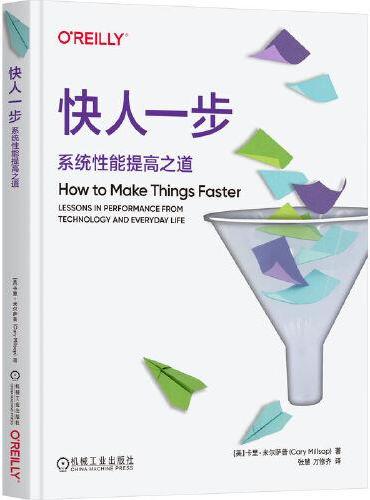新書推薦:

《
大宋理财:青苗法与王安石的金融帝国(全彩插图本)
》
售價:NT$
500.0

《
安全感是内心长出的盔甲
》
售價:NT$
305.0

《
快人一步:系统性能提高之道
》
售價:NT$
505.0

《
我们为什么会做梦:让梦不再神秘的新科学
》
售價:NT$
352.0

《
算法图解(第2版)
》
售價:NT$
356.0

《
科学的奇幻之旅
》
售價:NT$
352.0

《
画艺循谱:晚明的画谱与消闲
》
售價:NT$
653.0

《
新民说·现实政治史:从马基雅维利到基辛格
》
售價:NT$
454.0
|
| 編輯推薦: |
|
本书可作为学生学习纳米光子学课程的参考书,也可作为高校纳米光子学研究领域的科研参考书,此外,本书还可以作为教授纳米光子学与光谱课程的教师的教学参考书。本书语言简单,朴实,通俗易懂,是研究纳米光子学领域研究生的必读书籍。
|
| 內容簡介: |
|
本书详细介绍了纳米光子和光谱的原理和应用。首先通过高真空尖端增强拉曼光谱仪揭示了表面等离激元增强的线性拉曼光谱的物理机制,然后详细介绍了表面等离激元增强的非线性拉曼光谱的实验和理论研究,以及双光子激发荧光和二次谐波产生信号的原位同步测量。本书物理概念清晰详细,全面介绍了本领域的*研究成果。本书可作为科研院所和大学科研工作者从事本领域科学研究的参考资料,也可作为物理系专业研究生和高年级本科生学习纳米光子学领域的参考书。
|
| 關於作者: |
|
北京科技大学担任教授和博导。孙萌涛教授长期从事基于表面等离激元增强的分子拉曼光谱的实验和理论研究,研发高真空针尖增强拉曼光谱仪,实现目标分子拉曼光谱的超灵敏检测,并揭示表面等离激元增强拉曼光谱的物理和化学机制,以通讯作者(或第一作者)在国际重要学术期刊上发表SCI论文超过180篇(其中ESI高引论文11篇),所有论文引用超过6100次,H-index 43,曾15次应邀在国际重要学术期刊撰写本领域的综述,应邀撰写英文专著(科学出版社)五本第一作者。2017年2月,孙萌涛教授获得辽宁省科学技术(自然科学)二等奖(个人第二)。
|
| 目錄:
|
CONTENTS
CHAPTER 1Introduction
1.1Concept of Spectroscopy
1.2Concept of Photonics and Plasmonics
1.3Concept of PlasmonEnhanced Spectroscopy
1.3.1Plasmonenhanced fluorescence
1.3.2Plasmonenhanced resonance fluorescence energy
transfer
1.3.3Surfaceenhanced Raman scattering
1.3.4The remoteexcitation of SERS
1.3.5Tipenhanced Raman scattering spectroscopy
1.3.6Remote excitationTERS microscopy
1.3.7Plasmonenhanced coherence antiStokes
Raman scattering images
References
CHAPTER 2Molecular Spectroscopy
2.1Jablonski Diagram
2.2Electronic State Transition
2.2.1Ultravioletvisiblenear IR absorption
spectroscopy
2.2.2Twophoton absorption spectroscopy
2.2.3Fluorescence spectroscopy
2.2.4Fluorescence resonance energy transfer
2.3Vibration Spectroscopy
2.3.1Raman spectroscopy
2.3.2Infrared spectroscopy
2.3.3Modes of molecular vibration
2.3.4The difference between Raman and spectra
2.4Rotational State
2.5Electronic and Vibrational Spectroscopy by Circularly
Polarized Light
2.5.1Electronic circular dichroism
2.5.2Raman optical activity
References
CHAPTER 3Photonics and Plasmonics
3.1Introduction
3.2Exciton
3.2.1Brief introduction of exciton
3.2.2Exciton classification
3.3Polariton
3.3.1Brief introduction of polariton
3.3.2Polariton types
3.4Plasmon and Surface Plasmons
3.4.1Plasmons
3.4.2Surface plasmons
3.4.3Surface plasmon polaritons
3.5PlasmonExciton Coupling: Plexciton
References
CHAPTER 4Surface Plasmon
4.1Brief Introduction of Surface Plasmon
4.2Physical Mechanism of Surface Plasmon
4.2.1Drude model
4.2.2Relationship between refractive index and
dielectric constant
4.2.3Dispersion relation
4.3Localized Surface Plasmon
4.4Plasmonic Waveguide
4.4.1The electromagnetic theory for calculating NWs
4.4.2The decay rate in the plasmon mode
4.4.3The spontaneous emission near the nanotip
4.4.4SPP modes of Ag NW by one end excitation
References
CHAPTER 5PlasmonEnhanced Fluorescence Spectroscopy
5.1The Principle of PlasmonEnhanced Fluorescence
5.2PlasmonEnhanced Upconversion Luminescence
5.2.1Brief introduction
5.2.2Physical principle and mechanism
5.3Principle of PlasmonEnhanced FRET
References
CHAPTER 6PlasmonEnhanced Raman Scattering Spectra
6.1SurfaceEnhanced Raman Scattering Spectroscopy
6.1.1Brief history of SERS spectroscopy
6.1.2Physical mechanism of SERS spectroscopy
6.2TipEnhanced Raman Scattering Spectroscopy
6.2.1Brief introduction of TERS spectroscopy
6.2.2Physical mechanism of TERS spectroscopy
6.2.3Setup of TERS
6.3RemoteExcitation SERS
References
CHAPTER 7HighVacuum TipEnhanced Raman Scattering
Spectroscopy
7.1Brief Introduction
7.1.1Brief description of setup of HVTERS
7.1.2Detailed description of setup of HVTERS
7.2The Application of HVTERS Spectroscopy in in situ
PlasmonDriven Chemical Reactions
7.3Plasmonic Gradient Effect
7.4Plasmonic Nanoscissors
References
CHAPTER 8Physical Mechanism of PlasmonExciton Coupling
Interaction
8.1Brief Introduction of Plexcitons
8.2PlasmonExciton Coupling Interaction
8.2.1Strong plasmonexciton coupling interaction
8.2.2Application of strong plasmonexciton coupling
interaction
8.2.3Weak plasmonexciton coupling interaction
8.2.4Application of weak plasmonexciton coupling
interaction
8.2.5Plexcitons
8.3Application
8.3.1Plasmonic electronsenhanced resonance Raman
scattering and electronsenhanced fluorescence
spectra
8.3.2Tipenhanced photoluminescence spectroscopy
8.3.3Femtosecond pumpprobe transient absorption
spectroscopy
References
CHAPTER 9PlasmonExcitonCoDriven Surface Catalysis Reactions
9.1PlasmonExcitonCoDriven Surface Oxidation Catalysis
Reactions
9.2PlasmonExcitonCoDriven Surface Reduction Catalysis
Reactions
9.3Unified Treatment for PlasmonExcitonCoDriven Oxidation
and Reduction Reactions
References
CHAPTER 10Nonlinear Optical Microscopies of CARS,TPEF,SHG,
SFG and SRS
10.1Principles of Nonlinear Optical Microscopies
10.2Applications of Nonlinear Optical Microscopies
10.2.1Optical characterizations of 2D materials
10.2.2Highly efficient photocatalysis of gC3N4
10.2.3Optical characterizations of 3D materials
10.2.4Advances of biophotonics
10.2.5MSPRenhanced nonlinear optical microscopy
References
Acknowledgements
|
|










